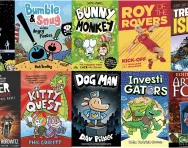Important update from TheSchoolRun
For the past 13 years, TheSchoolRun has been run by a small team of mums working from home, dedicated to providing quality educational resources to primary school parents. Unfortunately, rising supplier costs and falling revenue have made it impossible for us to continue operating, and we’ve had to make the difficult decision to close. The good news: We’ve arranged for another educational provider to take over many of our resources. These will be hosted on a new portal, where the content will be updated and expanded to support your child’s learning.
What this means for subscribers:
- Your subscription is still active, and for now, you can keep using the website as normal — just log in with your usual details to access all our articles and resources*.
- In a few months, all resources will move to the new portal. You’ll continue to have access there until your subscription ends. We’ll send you full details nearer the time.
- As a thank you for your support, we’ll also be sending you 16 primary school eBooks (worth £108.84) to download and keep.
A few changes to be aware of:
- The Learning Journey weekly email has ended, but your child’s plan will still be updated on your dashboard each Monday. Just log in to see the recommended worksheets.
- The 11+ weekly emails have now ended. We sent you all the remaining emails in the series at the end of March — please check your inbox (and spam folder) if you haven’t seen them. You can also follow the full programme here: 11+ Learning Journey.
If you have any questions, please contact us at [email protected]. Thank you for being part of our journey it’s been a privilege to support your family’s learning.
*If you need to reset your password, it will still work as usual. Please check your spam folder if the reset email doesn’t appear in your inbox.
16 ways to help a struggling reader in Key Stage 2

It’s often taken for granted that children are able to read fluently by the time they move up to Key Stage 2.
But according to SATs results in 2016, one in three children left primary school unable to read at the expected standard, rising to 51% of those from families who receive free school meals.


Start a unique learning programme!
- Weekly programme for each school year
- Worksheets sent direct to your inbox
- Keeps your child's learning on track
Why do some children struggle with reading?
There are many factors affecting children’s reading ability. Boys are more likely to have difficulty than girls, and, as SATs results show, children from poorer homes tend to lag behind. ‘Poverty and literacy are very closely linked; studies show that these children start school on average 19 months behind their peers, and many struggle to catch up,’ says Sinead Naidoo, programme manager of the Young Readers Programme at the National Literacy Trust.
Children who come from families where reading isn’t valued are more likely to have problems. ‘A reading culture is so important, yet one in seven children doesn’t have a single book to call their own,’ Sinead explains.
Other possible causes of reading difficulties include special educational needs (SEN) such as dyslexia, poor concentration or attention span, an insufficient grasp of phonics, and problems with eyesight.
The implications of having problems with reading are far-reaching. ‘Children with a poor level of literacy learn less and are limited in their entire education,’ says Sinead. ‘It determines who their friends are, the sort of games they play at breaktime, and their self-esteem. Because they can’t read well, they can’t learn independently, so they don’t meet expectations at school, and, later on, have trouble accessing the job market and supporting their own children’s learning.’
The good news is that whatever your child’s difficulty with reading, there are ways to help them catch up.
1. Have your child’s needs assessed
The first step is to eliminate any physical, medical or mental reasons for your child’s reading difficulties. ‘It could be as simple as booking an eye test,’ Sinead says. If you’re concerned that your child has a special educational need, your first port of call should be your GP, who can advise you on next steps and, if necessary, refer your child to a specialist such as an educational psychologist.
2. Talk to their teacher
Sometimes schools are well aware of a child’s reading difficulties, but sometimes they fly under the radar, which means it’s important to talk to the school about what’s happening.
Although children who haven’t passed the phonics screening check by the end of Year 2 don’t have to sit the test again, they should be given ongoing support with their reading. This could take the form of intensive phonics work on a one-to-one or small group basis, guided reading with a group of children with a similar reading level, or help from a teaching assistant (TA) or reading volunteer.
3. Make your home reading-friendly
‘It’s really important to cultivate a reading environment in the home, where children have access to books,’ Sinead says. ‘You can be a great reading role model by letting your child see you reading, and reading actual books rather than just on your phone.’
4. Take turns at reading
Reading can be tiring for children who find it difficult, and this can put them off reading for pleasure, especially if the sort of books they’d like to read are just too tricky. Reading together and taking it in turns to read a paragraph or page is a good way to help your child practise their reading without getting too exhausted by it.
5. Remove the fear of failure
Children who struggle with reading can also struggle with self-esteem, perceiving themselves as ‘stupid’ or ‘lazy’ compared to their classmates. But the ability to learn from your mistakes is a real asset. ‘Try modelling mistake-making yourself, pretending to get a word wrong and then working it out,’ suggests Sinead.
6. Help them with difficult words
It can be hard to know what to do if your child gets stuck on a word. Sometimes, you might want to just to tell them what it is, for example if they’re getting bored or frustrated, or if it’s a particularly difficult word. But on the whole, it’s best to give them a little time to work it out for themselves, before prompting them to use their phonics knowledge or the picture clues on the page.
7. Use age-appropriate reading books like hi-low readers
The humiliation of not being able to read fluently can be compounded if your child is also condemned to read books that are far too babyish for their actual age. High-low readers are reading scheme books that are based on topics that older children will enjoy, but with text suited to their lower reading ability. Schools often use these reading schemes, such as Oxford University Press’s Project X – designed for boys who struggle with reading – so that children are not noticeably behind their peers.
Other hi-low reading series include:
- Goal!
- Badger Learning Hi-Low Readers
- Dockside by Rising Stars
- The College Collection by Crownhouse Publishing
- Bloomsbury High Low fiction including the Mission Alert and Skate Monkey series
- Accelerated Readers from Pandora Books
- The huge selection of high-low reading series from Phonics Books.
8. Read to a pet
Reading to the cat or dog, or to a younger sibling who can’t yet read, is a great way for your child to practise their skills without pressure. ‘There’s something very comforting about reading out loud without the fear of being judged,’ says Sinead.
9. Choose easy-to-read texts
The way the text appears on the page can make a big difference to how easy children find it to read. If your child finds reading tough, Oxford University Press’s Oxford Owl website recommends looking for books that have the following characteristics:
- Cream paper, rather than bright white, which can strain the eyes
- Thick paper so that words don’t show through from the other side
- A clear font that’s not too small and has plenty of space between words, and not too many italics or underlined passages
- Sentences that are all a similar length, rather than very short or very long
- Clear, uncluttered pages with text broken up into clear paragraphs, boxes, bullet points or lists
- Text and pictures positioned separately on the page, rather than the text wrapping around or overlapping the text.
10. Make reading cool
Children are much more likely to read for pleasure – and so develop their skills – if reading is seen as cool or popular. There are lots of programmes that aim to encourage children to read, such as Premier League Reading Stars, run in partnership with the National Literacy Trust, which uses the support of famous footballers to make reading appeal to children. You can nominate your child’s school to get involved.
11. Use technology
Technology is far from the devil’s work when it comes to encouraging struggling or reluctant readers. ‘There are lots of great reading games and apps for smartphones and tablets, and audiobooks are also great because they develop an understanding of how written language differs from spoken,’ says Sinead.
12. Encourage your child to choose their own books
Being able to choose books independently is an important goal for children who are struggling to read, whether that’s at the library, in a bookshop or online. If your child chooses a book that appeals to their interests or links to their experience, they’re more likely to persevere with it. A good rule, when choosing a book, is to open it at random. Get your child to hold up five fingers, and put one down for every word on that page that is too difficult. If they use up all five fingers, the book is likely to be too advanced for them.
13. Don’t stick to fiction
Some children simply aren’t enthused by fiction, but that doesn’t mean they’re destined never to read for pleasure. Non-fiction books, comics, magazines and graphic novels are perfectly valid reading materials; all reading practice is good practice.
14. Read out loud every day
Okay, so it can be frustrating to still be reading aloud to your child at an age where most children are reading independently, but try to make time for just 10 minutes’ reading each day. Research shows that reading aloud to your child is one of the most important things you can do to encourage both their reading ability and their enthusiasm for books.
15. Talk about books
Reading is more than just being able to decode the words; your child also needs to understand the plot. ‘Talk to your child about what they’re reading,’ advises Sinead. ‘Ask them what they’ve been reading at school. What’s the book about? Are they enjoying it? Who’s their favourite character? This will not only help their comprehension, but your interest will also act as an encouragement.’
16. Keep your patience
We never grow out of being praised, so make sure your child gets due credit for their reading. Try to keep your frustration or impatience off your face and out of your tone of voice, and make sure you celebrate their reading victories. Be specific about what they’ve done well: ‘you sounded that word out perfectly’ is much more effective than ‘well done!’ Join schemes that incentivise reading, such the Summer Reading Challenge, which many libraries take part in. And if you or your child is getting fraught or impatient, bring the reading session to an end: persevering when it’s going badly risks them developing a negative attitude towards reading.








